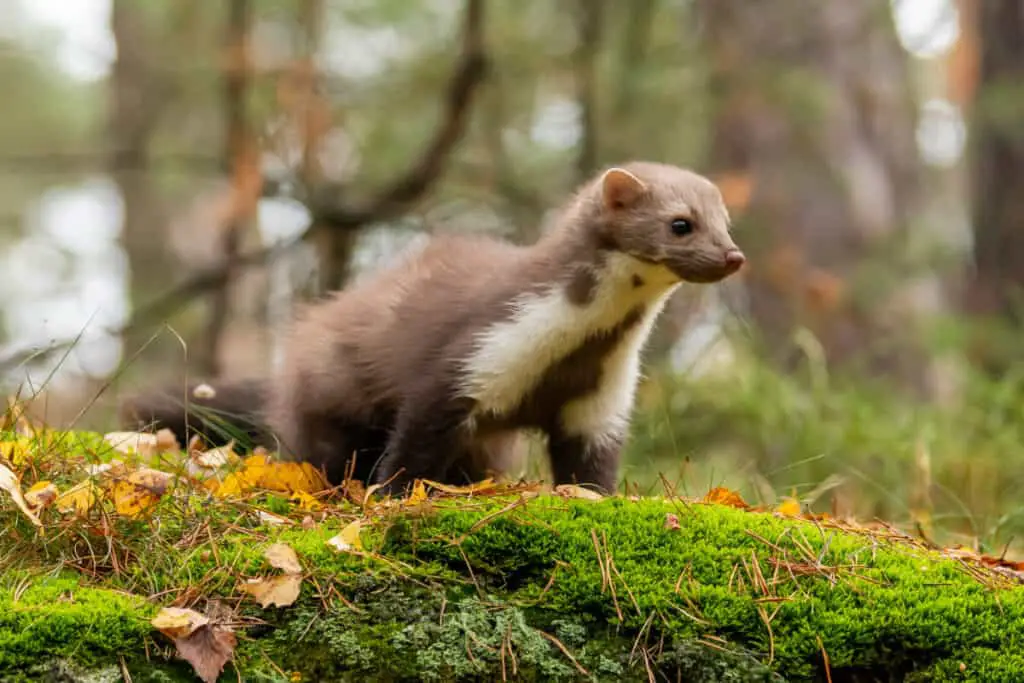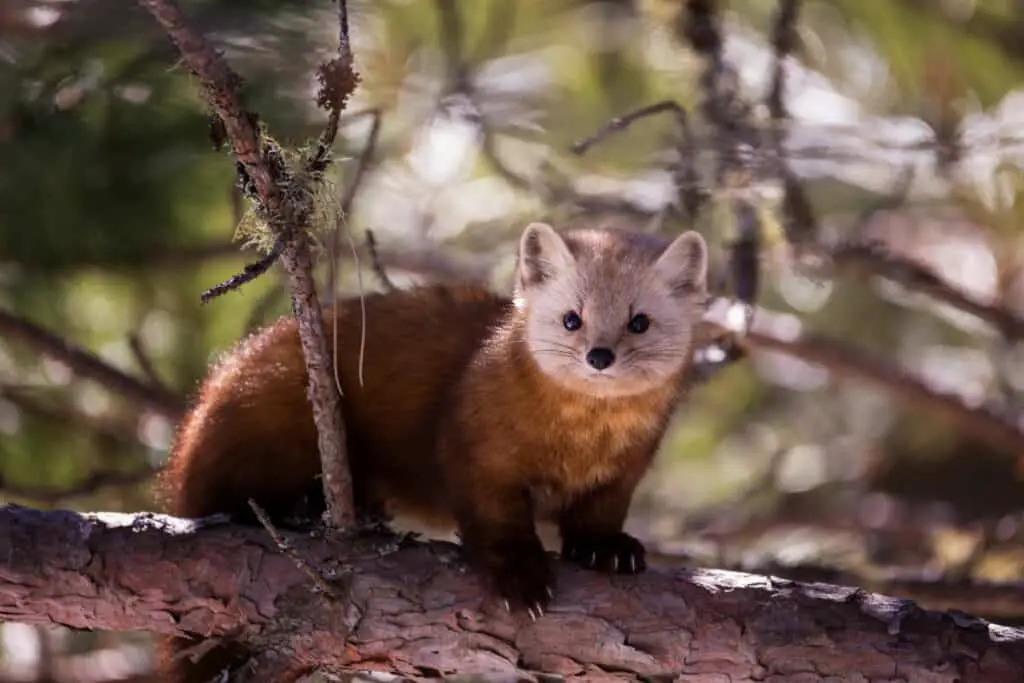The Pine Marten is a mammal belonging to the family Mustelidae. They are small carnivorous animals that are widely distributed across Europe and Asia.
The Pine marten has a slender body with short legs and a long bushy tail. The fur of pine martens varies from light brown to dark chocolate-brown in color, and they have distinctive creamy-yellow patches on their throat and chest.
Pine martens inhabit mixed woodland areas, coniferous forests, and rocky terrain. They are primarily nocturnal creatures but may also be active during daylight hours, especially during winter months when food availability is low.
Their diet consists mainly of small mammals such as voles, mice, squirrels, birds, insects, fruits, nuts, and seeds. Pine martens play an essential role in controlling rodent populations in their habitat by preying on them.
In this article, we will discuss the physical characteristics of pine martens along with their behavior patterns and ecological significance.

Physical Characteristics Of Pine Martens
The pine marten is a small predator that belongs to the Mustelidae family. It can be found throughout Europe and parts of Asia.
While many people believe that pine martens are strictly arboreal animals due to their name, they actually spend most of their time on the ground and only climb trees occasionally.
Pine martens have several physical characteristics that make them well-suited for their environment. They have long bodies with short legs, which allows them to move easily through dense forest undergrowth. Their fur is thick and soft, ranging from pale yellow-brown to dark brown-black depending on the subspecies. Additionally, pine martens have sharp claws and teeth that help them catch prey such as rodents, birds, insects, and even fruit.
In terms of behavioral patterns, pine martens are solitary creatures that live in dens or tree hollows. They are primarily nocturnal but may also be active during the day if food sources are scarce.
Breeding habits vary by region but typically occur between July and August when females give birth to litters of 1-5 kits after a gestation period of around seven months.
Life of a Marten: Unveiling Their Lifecycle
Habitat And Distribution Of Pine Martens
Pine martens are found in various habitats across Europe and Asia, including dense forests, rocky areas, and mountainous regions. They prefer to live in areas with an abundance of trees where they can build their dens. Pine martens require a wide range of food sources, including small mammals such as voles and mice, birds, insects, fruits, and nuts.
However, habitat destruction has led to a decline in the pine marten population. One factor contributing to the decline is deforestation for timber production or conversion into agricultural land. This loss of forest cover reduces the availability of suitable habitats for pine martens. Another cause is hunting for fur trade which significantly impacted populations in the past centuries. As predators at the top of their food chain, pine martens play an essential role in maintaining ecosystem balance by regulating prey populations. Therefore it is crucial that conservation efforts focus on protecting their habitats from further degradation.
The following are some interesting facts about Pine Marten:
- They have sharp claws that help them climb trees easily.
- An adult weighs between 1–2 kg (2.2–4.4 lb) and measures 45–58 cm (18–23 inches) long.
- In folklore across many cultures, this animal symbolizes good luck and wealth.
- Pine martens are known for their agility and speed, and are excellent hunters of small mammals, birds, and insects.
Martens Revealed: Exploring Their Unique Characteristics
Nocturnal Behavior Of Pine Martens
The habitat and distribution of pine martens have been discussed in the previous section. Now, it is important to examine their nocturnal behavior, particularly their hunting strategy and communication techniques.
Pine martens are known to be active at night and rely on a combination of stealth, agility, and acute senses when hunting for prey. When searching for food, pine martens move quietly through trees and along branches, using their sharp claws to climb and leap with ease. Their main source of sustenance includes small mammals such as voles, mice, squirrels, birds, eggs, insects, fruits, and nuts. They also consume carrion when available.
To catch prey successfully, they use quick movements to pounce or ambush them from above or behind. Once caught, they may carry it away or eat immediately without any specific pattern observed so far.
Furthermore, pine marten’s communication techniques include vocalizations such as growls, hisses squeaks rather than loud calls used by other species. Moreover, scent marking in which animals release odors that signal territorial boundaries or mating status is another form of communication utilized by these carnivores.
Unraveling Martens: Understanding Their Behavior
Diet And Prey Of Pine Martens
As a predator, the pine marten is known for its cunning hunting techniques. It stalks through the forest floor with grace and agility, ready to pounce on unsuspecting prey. Its diet consists mainly of small mammals like voles, mice, squirrels, and rabbits. However, it has also been observed eating birds, insects, and even carrion.
The impact of pine martens on prey populations can be significant. Studies have shown that their presence in an area can lead to a decrease in rodent populations due to predation. This can have a positive effect on ecosystems by preventing overgrazing or damage from burrowing rodents. On the other hand, if pine martens become too abundant in an area where larger game animals are scarce, they may turn to preying on smaller species such as songbirds.
Overall, the role of the pine marten in maintaining balance within ecosystems is complex and warrants further research.
- Pine martens use their sharp claws to climb trees and catch arboreal prey.
- They are skilled at ambushing ground-dwelling animals by hiding behind cover until their target comes into range.
- In winter months when food is scarcer, they will dig through snow to find hibernating rodents.
- Pine martens have even been known to swim across bodies of water in pursuit of aquatic prey such as fish or frogs.
Unveiling Marten’s Senses: A Fascinating Journey
Ecological Significance Of Pine Martens
Having discussed the diet and prey of pine martens, it is important to understand their role in the ecosystem. Pine martens are considered a keystone species due to their impact on the community structure and function in forest ecosystems.
They play an essential role in controlling the populations of small mammals such as voles and mice which can cause damage to tree seedlings and other vegetation through herbivory or burrowing activities.
Furthermore, pine martens also contribute significantly to maintaining biodiversity by preying on bird eggs and fledglings, thus limiting the population growth of certain bird species. Due to their importance in regulating prey populations and contributing to overall ecosystem health, any decline in pine marten numbers could have significant implications for forest communities.
Despite this ecological significance, pine martens face several threats that could potentially lead to their extirpation from some areas. These include habitat loss due to forestry practices, road mortality, hunting pressure, and competition with invasive species like grey squirrels. It is imperative that conservation efforts be implemented to ensure that these animals continue playing their vital role within forest ecosystems.
The survival of the pine marten is crucial not only for its own sake but for the well-being of entire forest ecosystems they inhabit. As we move forward into a future where human activities will increasingly threaten wildlife habitats, there must be greater awareness concerning our actions’ potential consequences on nature’s balance.
We must work towards developing sustainable resource management plans that prioritize both economic interests while protecting natural resources upon which all life depends without compromising endangered species like pine martens.
Unveiling Marten’s Palate: What Animals Eat Martens
Conservation Status Of Pine Martens
The conservation status of pine martens has been a cause for concern in recent years due to various threats that they face. One of the primary threats is habitat loss and fragmentation, caused by deforestation and urbanization. As their natural habitats are destroyed or altered, pine martens struggle to find suitable places to live and hunt, which leads to declines in population numbers.
Additionally, hunting and trapping pose significant risks to these animals as they are often mistaken for other species such as American minks or feral cats. Conservation efforts have been put forth to address these issues and protect the pine marten populations. These efforts include habitat restoration projects aimed at creating suitable environments for them to thrive in, as well as stricter regulations on hunting and trapping practices.
Furthermore, captive breeding programs have been established in some areas where populations have severely declined. Through these measures, it is hoped that the pine marten’s conservation status can be improved, ensuring that future generations continue to enjoy this fascinating animal’s presence in our forests.
Unraveling Martens: Understanding Their Behavior

Conclusion
Pine martens are small, carnivorous mammals that inhabit the forests of Europe and Asia. They have a slender body with soft fur that ranges from dark brown to yellowish-brown in coloration. Their habitat includes old-growth forested areas with plenty of hiding places such as hollow trees or rock crevices.
Pine martens are solitary creatures that hunt at night, feeding on a variety of prey including rodents, birds, insects, and fruits. These animals play an important ecological role by controlling the population of their prey species. Additionally, pine martens contribute to maintaining the health of forest ecosystems through seed dispersal while foraging for food.
Despite being protected under various conservation measures, these animals continue to face threats such as habitat loss due to deforestation and human activities. One interesting statistic is that in Scotland, where pine marten populations had declined significantly due to hunting and habitat loss in the 19th century, reintroduction efforts have led to a remarkable recovery.
The number of pine martens has increased by more than 7 times since the first reintroductions began in the 1980s. This success story highlights the crucial role humans can play in preserving threatened wildlife populations through restoration efforts and protection measures.

